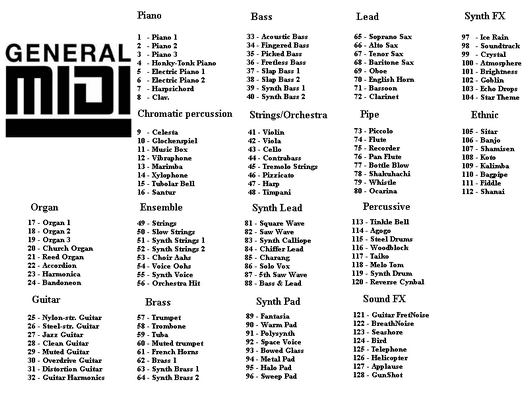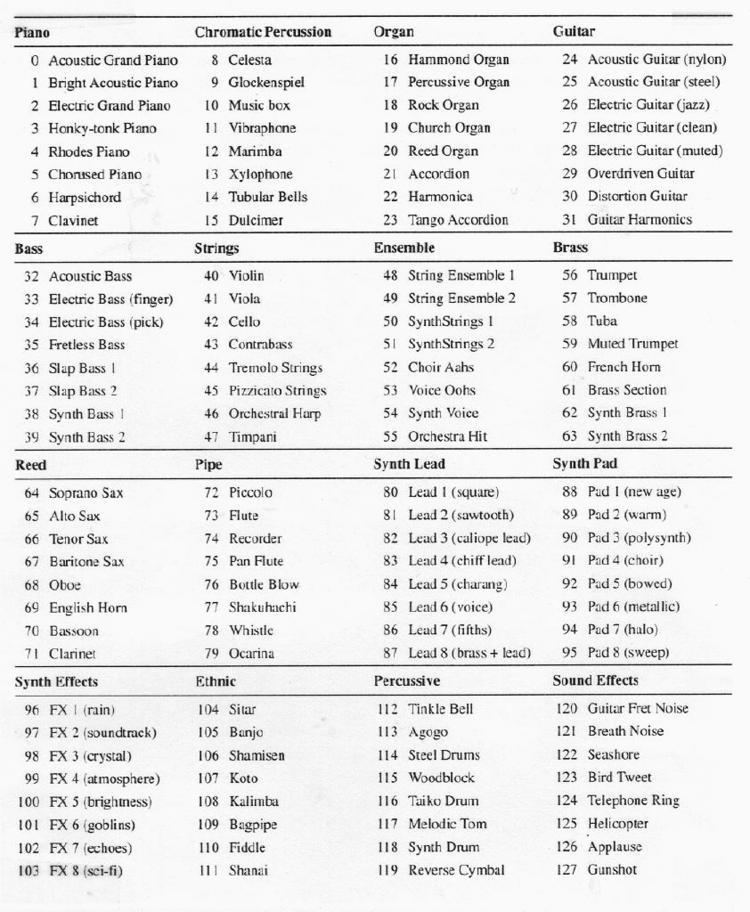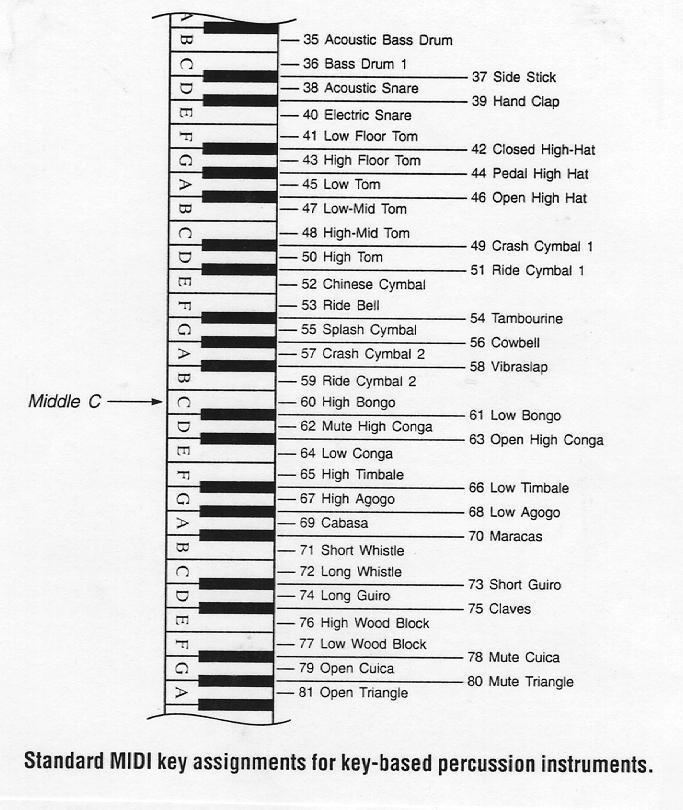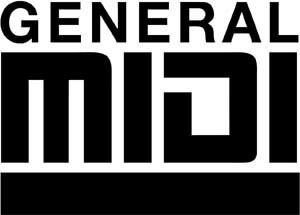 | ||
Similar General MIDI Level 2, Media Vision Pro AudioSpectrum, Roland Sound Canvas | ||
General midi the eastoner
General MIDI or GM is a standardized specification for electronic musical instruments that respond to MIDI messages. GM was developed by the American MIDI Manufacturers Association (MMA) and the Japan MIDI Standards Committee (JMSC) and first published in 1991. The official specification is available in English from the MMA, bound together with the MIDI 1.0 specification, and in Japanese from the Association of Musical Electronic Industry (AMEI).
Contents
- General midi the eastoner
- Parameter interpretations
- Program change events
- Piano
- Chromatic Percussion
- Organ
- Guitar
- Bass
- Strings
- Ensemble
- Brass
- Reed
- Pipe
- Synth Lead
- Synth Pad
- Synth Effects
- Ethnic
- Percussive
- Sound effects
- Percussion
- Controller events
- RPN
- System Exclusive messages
- GS extensions
- General MIDI Level 2
- Official MIDI Standards Organizations
- References

GM imposes several requirements beyond the more abstract MIDI 1.0 specification. While MIDI 1.0 by itself provides a communications protocol which ensures that different instruments can interoperate at a fundamental level (e.g., that pressing keys on a MIDI keyboard will cause an attached MIDI sound module to play musical notes), GM goes further in two ways: it requires that all GM-compatible instruments meet a certain minimal set of features, such as being able to play at least 24 notes simultaneously (polyphony), and it attaches specific interpretations to many parameters and control messages which were left under-specified in the MIDI 1.0 spec, such as defining instrument sounds for each of the 128 possible program numbers.

GM instruments are required to be able to:

Parameter interpretations
GM Instruments must also obey the following conventions for program and controller events:
Program change events

In MIDI, the instrument sound or "program" for each of the 16 possible MIDI channels is selected with the Program Change message, which has a Program Number parameter. The following table shows which instrument sound corresponds to each of the 128 possible Program Numbers for GM only. There are 128 program numbers. The numbers can be displayed as values 1 to 128, or, alternatively, as 0 to 127. The 0 to 127 numbering is usually only used internally by the synthesizer; the vast majority of MIDI devices, digital audio workstations and professional MIDI sequencers display these Program Numbers as shown in the table (1-128).
Piano

Chromatic Percussion
Organ
Guitar

Bass
Strings
Ensemble
Brass
Reed
Pipe
Synth Lead
Synth Pad
Synth Effects
Ethnic
Percussive
Sound effects
Percussion
In GM standard MIDI files, channel 10 is reserved for percussion instruments only. Notes recorded on channel 10 always produce percussion sounds when transmitted to a keyboard or synth module which uses the GM standard. Each of the 128 different possible note numbers correlate to a unique percussive instrument, but the sound's pitch is not relative to the note number.
If a MIDI file is programmed to the General MIDI protocol, then the results are predictable, but the sound fidelity may vary depending on the quality of the GM synthesizer:
Controller events
In MIDI, adjustable parameters for each of the 16 possible MIDI channels may be set with the Control Change message, which has a Control Number parameter and a Control Value parameter. GM also specifies which operations should be performed by multiple Control Numbers:
1 Modulation wheel
7 volume
10 pan
11 Expression
64 Sustain pedal
100 Registered Parameter Number LSB
101 Registered Parameter Number MSB
121 All controllers off
123 All notes off
RPN
GM defines several Registered Parameters, which act like Controllers but are addressed in a different way. In MIDI, every Registered Parameter is assigned a Registered Parameter Number or RPN. Registered Parameters are usually called RPNs for short.
Setting Registered Parameters requires sending (numbers are decimal):
- two Control Change messages using Control Numbers 101 and 100 to select the parameter, followed by
- any number of Data Entry messages of one or two bytes (MSB = Controller #6, LSB = Controller #38), and finally
- an "End of RPN" message
The following global Registered Parameter Numbers (RPNs) are standardised (the parameter is specified by RPN LSB/MSB pair and the value is set by Data Entry LSB/MSB pair):
0,0 Pitch bend range
1,0 Channel Fine tuning
2,0 Channel Coarse tuning
For example: RPN control sequence to set coarse tuning to A440 (parm 2, value 64):
101:0, 100:2, 6:64, 101:127, 100:127
System Exclusive messages
Two GM System Exclusive ("SysEx") messages are defined: one to enable and disable General MIDI compatibility mode (for synthesizers that also have non-GM modes); and the other to set the synthesizer's master volume.
GS extensions
A superset of the General MIDI standard which added several proprietary extensions. The most notable addition was the ability to address multiple banks of programs (instrument sounds) by using an additional pair of Bank Select controllers to specify up to 16384 "variation" sounds (cc#0 is Bank Select MSB, and cc#32 is Bank Select LSB). Other most notable features were 9 Drum kits with 14 additional drum sounds each, simultaneous Percussion Kits - up to 2 (Channels 10/11), Control Change messages for controlling the send level of sound effect blocks (cc#91-94), entering additional parameters (cc#98-101), portamento, sostenuto, soft pedal (cc#65-67), and model-specific SysEx messages for setting various parameters of the synth engine.
GS was introduced in 1991 with the Roland Sound Canvas line, which was also Roland's first General MIDI synth module.
General MIDI Level 2
In 1999, the official GM standard was updated to include more controllers, patches, RPNs and SysEx messages, in an attempt to reconcile the conflicting and proprietary Roland GS and Yamaha XG additions. Here's a quick overview of the GM2 changes in comparison to GM/GS:
Additional melodic instruments can be accessed by setting CC#0 to 121 and then using CC#32 to select the bank before a Program Change.
